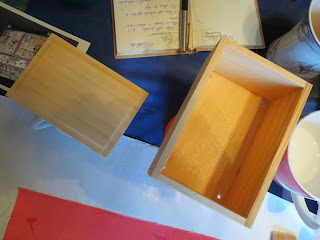I am at a hotel in Bournemouth with complete strangers. I met ‘the strangers’ at dinner last night and again at breakfast this morning. They are very friendly and welcoming but they talk about things I don’t yet know about and use words I don’t yet understand. I think that everyone knows everyone else except me – that is not entirely true, there are two other ‘new girls’. I miss my (future) husband and feel very home sick. I think that I have made a mistake coming here. I don’t think I am up to the task ahead. I think I am going to make a fool of myself. But I am here now and this is something I really, really, want to do. I am about to take my first class in Japanese Embroidery.
© JEC/Carol-Anne Conway
When the class began those concerns were soon forgotten, not because I was feeling any more confident but because I simply did not have time to feel nervous or inadequate; there is so much to learn just to get going with Japanese embroidery. We ‘new girls’ were each assigned a mentor to guide us through the framing up process. Our tutor that week was also my mentor. Poor Jenny, I think I drove her mad with my incessant questions but she bore it with patience and good humour.
In order to keep up with the syllabus Ruth, Maggie and I (the ‘new girls’) were assigned homework at the end of each class. Ruth was staying at a guest house with her husband and took her homework to do there. After dinner Maggie and I would return to the class room and put in many hours to complete our homework sometimes working long after everyone else had retired for the day. The beautiful Maggie is a beautiful stitcher, I was in awe of her work right from the beginning.
© JEC/Carol-Anne Conway
By the end of that week I had learnt so much and some new and precious friendships had begun. Since then Japanese embroidery has become my passion. When I enrolled for my first class, I had not thought beyond that. I certainly had not envisaged that one day I would be aiming to go to Atlanta to do my Phase X. At that time I had not heard of Japanese bead embroidery (or even bead embroidery for that matter). Once I knew about it, I knew I wanted to learn it and as soon as a tutor qualified in the UK I enrolled for her first class. That was the beginning of a new adventure for my dear friend Sue and me but we never imagined that it would lead us to the JEC in Atlanta for Phase V and that we ourselves would qualify as Japanese Bead embroidery tutors.
© JEC/Carol-Anne Conway
At first, I only attended the spring class in Bournemouth once a year. Gradually I started going to shows to demonstrate JE and I think it was then that I realised how my confidence had grown since that shaky start.
When the lovely Denise and equally lovely Jane began classes in Garstang, whenever I could I joined their class. It has been a privilege to watch that group grow under Denise and Jane’s gentle tutoring. I was honoured to celebrate their 5 year anniversary with them in October last year. And there I have made more new friends. I travelled with a group of them to Japan in 2013 for a fantastic holiday. Something else I never imagined I would do.
© JEC/Carol-Anne Conway
Although I did not begin blogging because of Japanese embroidery, the majority of my posts have been about JE or beading. When I started blogging I searched the internet to see if anyone else was blogging about JE. At the time the only other person I found was Susan of Plays with needles. Over the years we have become good friends and I am very much looking forward to meeting Susan in Atlanta later this year.
© JEC/Carol-Anne Conway
Unfortunately there have been some sad points in this adventure. In the past couple of years we have said good bye to three friends. Pat Hooper, a tutor I barely got to know but whose embroidery and knowledge made a lasting impression on me. Jenny Orchard, a beautiful stitcher and gentle soul. And my dear, dear friend Sue. Sue was the first person to befriend me and the one who encouraged me to help at exhibitions and to join the group in Garstang. Sue was the one who would not let me stich at home on my own and made my join in. I miss her so much.
© JEC/Carol-Anne Conway
Sad times apart, the last ten years have been the happiest of my life. That is in no small part down to Japanese embroidery and the friends I have made through it. Both have become so much part of my life that I cannot image a life without them now. And it all began one evening in September 2004 when Margaret Lewis, my sensei, gave a talk at the Oxford Branch of the Embroiderers Guild. When I walked into Iffley village hall that evening and saw Margaret’s work, I thought they were the most beautiful embroideries I had ever seen. I was fascinated as I listened to her talk about the silks and the techniques involved. And as I watched her twist threads from the flat silk, I knew this was something I had to learn.
© JEC/Carol-Anne Conway
To Margaret and all of the other tutors who have patiently guided me, and to all my other JE friends, thank you for all that you have taught me, thank you for your support and encouragement, thank you from the bottom of my heart.
Happy Stitching.





































